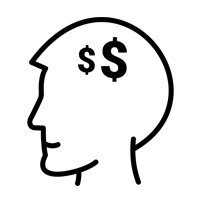Reference Point
The Basic Idea
Famed psychologists Daniel Kahneman and Amos Tversky are best known for developing prospect theory, a key contribution to the field of economics. Prospect theory, which was developed over the course of thirty years of extensive research, offers an explanation for typical patterns of risk and uncertainty management.1 The concept of a reference point is a principal feature of this theory.
Prospect theory suggests that when people are presented with alternatives, each with their own probability of gains and losses, they will assess the utility – the potential benefits – of each possible outcome, relative to a reference point – for example, how much money they currently have. They are not evaluating the absolute utility of each outcome, but rather the relative utility.2 The theory of loss aversion posits that people would rather take a risk to avoid a loss than take an equivalent risk in order to gain something of equivalent value.3 We depend on reference points in order to classify the potential outcomes of different options as gains or losses.4
An example of the role of reference points in prospect theory comes from a study conducted by Idris Adjerid and their colleagues, the results of which were published in 2013 in a paper titled “Sleights of privacy: Framing, disclosures, and the limits of transparency”.5 When people are presented with online privacy notices, they compare the level of protection offered to the level of protection offered by privacy notices that had previously been presented. Say, for example, a group of people in an online study are presented with privacy notice A, and then asked to answer a series of questions, while another group of people are presented first with privacy notice B, which offers a higher level of protection than privacy notice A, and then are subsequently presented with privacy notice A and asked to answer the same questions. People in the first group will disclose more information after seeing privacy notice A than will those in the second group. This is because the people in the second group are using privacy notice B, which is more protective, as a reference point and therefore view privacy notice A as insufficient and too risky.
An investment said to have an 80% chance of success sounds far more attractive than one with a 20% chance of failure. The mind can’t easily recognize that the two are the same.
– Daniel Kahneman
Theory, meet practice
TDL is an applied research consultancy. In our work, we leverage the insights of diverse fields—from psychology and economics to machine learning and behavioral data science—to sculpt targeted solutions to nuanced problems.
Key terms
Prospect theory
The behavioral model of prospect theory is used to represent how people manage risk and uncertainty when choosing between different options. It is based on the idea of loss aversion, which suggests that if people are presented with two equal options, one that is described in terms of potential gains and one that is described in terms of potential losses, they will choose the first.6 This theory is commonly applied in economics.
Framing
The framing effect is a cognitive bias that is at the root of prospect theory. Put simply, it is when the way information is presented influences our judgment. When given information about two equivalent options, we can be made to view one as more desirable, based on the way it is framed. In prospect theory, information is commonly framed in terms of gains or losses. Specifically, outcomes can be framed to appear favorable if they are presented as an opportunity to gain something relative to a reference point, whereas they can also be framed to appear unfavorable, if they are presented as a loss relative to a given reference point.
History
The concept of the reference point is a key aspect of prospect theory. This theory, which serves as a behavioral model for decision-making under uncertainty, was first introduced by psychologists Daniel Kahneman and Amos Tversky in their paper, “Prospect Theory: An Analysis of Decision Under Risk”, published in Econometrica in 1979.7 They continued to develop the theory over the next thirty years. In 1992, the famous duo published a paper entitled “Advances in Prospect Theory: Cumulative Representation of Uncertainty.” In this paper, the researchers expanded upon the existing version of prospect theory, developing what they called “cumulative prospect theory.”8 This updated version of the theory was developed to account for some issues with the mathematical models of prospect theory. Since its conception, prospect theory has been applied in many different areas, from economics to political science, in order to predict outcomes and understand the decision-making processes of different parties.
People
Daniel Kahneman
Psychologist Daniel Kahneman was born in Tel Aviv in 1934, and spent much of his childhood in France under the threat of Nazi Germany. His family returned to Palestine after the Second World War, just before the creation of the State of Israel. Kahneman has dedicated much of his career to the study of decision-making and the factors that influence the process. While he has gained recognition for his own work, such as his 1973 book on attention, he is best known for the research that came from his collaborative efforts with Amos Tversky.9 Together, the pair developed the theories behind various cognitive biases and heuristics, including the illusion of validity, the availability heuristic, and, the framing effect, which is a key concept in prospect theory. In 2002, Kahneman was awarded the Nobel Memorial Prize in Economic Sciences for his work on judgment and decision-making.10
Amos Tversky
Like Kahneman, Amos Tversky was born in what is now Israel. He is most famous for his collaborative efforts with Kahneman, in which they demonstrated that people are not always the “logical agents” that economic models had made them out to be. Instead, they proposed that people often behave irrationally, in predictable and systematic ways.11 Both he and his wife, Barbara Tversky, spent much of their careers working as cognitive psychologists at Stanford University.12 Tversky passed away in 1996, six years before Kahneman won the Nobel Prize for the research they had conducted together. Although the prize is not awarded posthumously, Kahneman has said that, to him, it is a joint prize, stating that he and Tversky were “twinned for almost a decade”.13
Consequences
When was the last time you bought something for $99.99? Would you have bought the same item for $100?
Understanding the role of reference points within the context of prospect theory is crucial when it comes to presenting another party with a decision or making a decision yourself. People can use cognitive biases, like the framing effect, to their advantage when presenting someone with different options to choose from.
Consider the fact that your income per year may seem high or low to you, depending on reference points you use by comparison, such as the incomes of your peers, your last income, or the incomes of your parents, when you were raised. A salary cannot be said to be absolutely high or low, but rather high or low relative to other salaries, used as reference points. Of course, using reference points to characterize your own salary can lead to certain negative social comparisons.
Controversies
Although prospect theory is highly acclaimed and has been applied to a variety of disciplines, it is not without its critics. Psychologists have argued that a weakness of this theory is that it fails to account for the full range of affective and emotional states and their influence over decision-making.14 Another common criticism is that, while references points are a key component of this theory, the explanation for why actors choose the reference points that they do is not sufficiently developed.15
Related TDL Content
What Can George Costanza Teach Us About Making Better Investment Choices?
George Costanza, the quirky sidekick from the hit sitcom Seinfeld, makes for an interesting case study. The disposition effect suggests that pride and regret heavily influence our investment decisions, a concept that academics have tried to explain using prospect theory. How do we avoid falling prey to the disposition effect? George had the same question, and he came to an interesting conclusion.
To learn more about prospect theory and how it can be applied in our daily lives, check out this article, which explores the ways in which this theory can be used to influence people’s decision to vote. This article highlights the importance of framing and how it can be used to boost voter turnout.
Sources
- Watkins, T. Kahneman and Tversky’s Prospect Theory. San José State University Economics Department. https://www.sjsu.edu/faculty/watkins/prospect.htm
- Prospect Theory. Behavioral Economics. https://www.behavioraleconomics.com/resources/mini-encyclopedia-of-be/prospect-theory/
- See 2
- Reference dependence. Behavioral Economics. https://www.behavioraleconomics.com/resources/mini-encyclopedia-of-be/reference-dependence/
- Adjerid, I., Acquisti, A., Brandimarte, L., & Loewenstein, G. (2013). Sleights of privacy: Framing, disclosures, and the limits of transparency. Proceedings of the Ninth Symposium on Usable Privacy and Security (SOUPS).
- Chen, J. (2020). Prospect Theory Definition. Investopedia. https://www.investopedia.com/terms/p/prospecttheory.asp
- Prospect Theory. Corporate Finance Institute. https://corporatefinanceinstitute.com/resources/knowledge/other/prospect-theory/
- Tversky A., and Kahneman, D. (1992). Advances in Prospect Theory: Cumulative Representation of Uncertainty. Journal of Risk and Uncertainty. 5, 297-323.
- Daniel Kahneman Biographical. The Nobel Prize. https://www.nobelprize.org/prizes/economic-sciences/2002/kahneman/biographical/
- Smith, D. (2002). Psychologist wins Nobel Prize. American Psychological Association. https://www.apa.org/monitor/dec02/nobel.html
- Goode, E. (2002). A Conversation with Daniel Kahneman. New York Times. https://www.nytimes.com/2002/11/05/health/a-conversation-with-daniel-kahneman-on-profit-loss-and-the-mysteries-of-the-mind.html
- Tversky, leading decision researcher, dies at 59. Stanford News Service. https://news.stanford.edu/pr/96/960605tversky.html
- See 10
- McDermott, R. (2016). Prospect Theory. Encyclopaedia Britannica. https://www.britannica.com/topic/prospect-theory
- See 7


